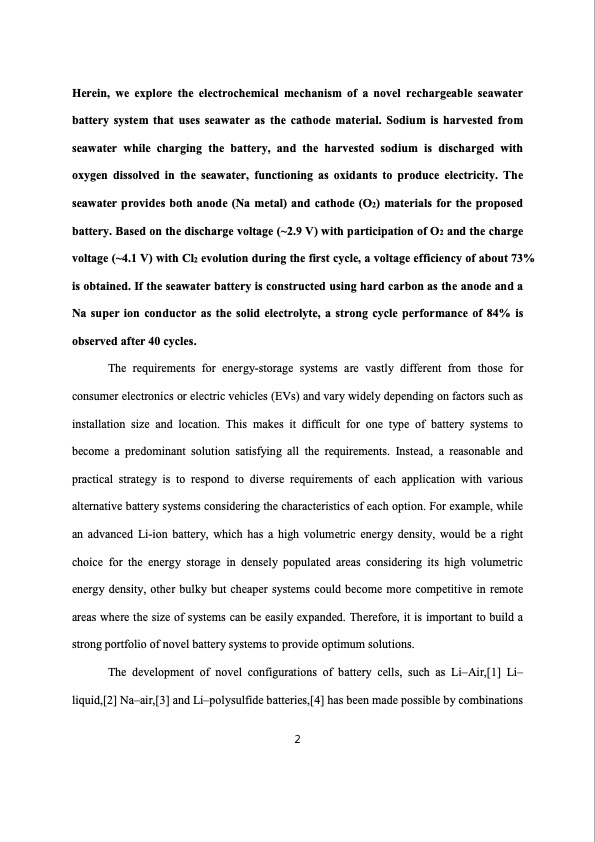
PDF Publication Title:
Text from PDF Page: 002
Herein, we explore the electrochemical mechanism of a novel rechargeable seawater battery system that uses seawater as the cathode material. Sodium is harvested from seawater while charging the battery, and the harvested sodium is discharged with oxygen dissolved in the seawater, functioning as oxidants to produce electricity. The seawater provides both anode (Na metal) and cathode (O2) materials for the proposed battery. Based on the discharge voltage (~2.9 V) with participation of O2 and the charge voltage (~4.1 V) with Cl2 evolution during the first cycle, a voltage efficiency of about 73% is obtained. If the seawater battery is constructed using hard carbon as the anode and a Na super ion conductor as the solid electrolyte, a strong cycle performance of 84% is observed after 40 cycles. The requirements for energy-storage systems are vastly different from those for consumer electronics or electric vehicles (EVs) and vary widely depending on factors such as installation size and location. This makes it difficult for one type of battery systems to become a predominant solution satisfying all the requirements. Instead, a reasonable and practical strategy is to respond to diverse requirements of each application with various alternative battery systems considering the characteristics of each option. For example, while an advanced Li-ion battery, which has a high volumetric energy density, would be a right choice for the energy storage in densely populated areas considering its high volumetric energy density, other bulky but cheaper systems could become more competitive in remote areas where the size of systems can be easily expanded. Therefore, it is important to build a strong portfolio of novel battery systems to provide optimum solutions. The development of novel configurations of battery cells, such as Li–Air,[1] Li– liquid,[2] Na–air,[3] and Li–polysulfide batteries,[4] has been made possible by combinations 2PDF Image | Rechargeable Seawater Battery

PDF Search Title:
Rechargeable Seawater BatteryOriginal File Name Searched:
1337148.pdfDIY PDF Search: Google It | Yahoo | Bing
Product and Development Focus for Salgenx
Redox Flow Battery Technology: With the advent of the new USA tax credits for producing and selling batteries ($35/kW) we are focussing on a simple flow battery using shipping containers as the modular electrolyte storage units with tax credits up to $140,000 per system. Our main focus is on the salt battery. This battery can be used for both thermal and electrical storage applications. We call it the Cogeneration Battery or Cogen Battery. One project is converting salt (brine) based water conditioners to simultaneously produce power. In addition, there are many opportunities to extract Lithium from brine (salt lakes, groundwater, and producer water).Salt water or brine are huge sources for lithium. Most of the worlds lithium is acquired from a brine source. It's even in seawater in a low concentration. Brine is also a byproduct of huge powerplants, which can now use that as an electrolyte and a huge flow battery (which allows storage at the source).We welcome any business and equipment inquiries, as well as licensing our flow battery manufacturing.| CONTACT TEL: 608-238-6001 Email: greg@salgenx.com | RSS | AMP |